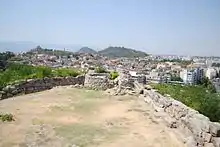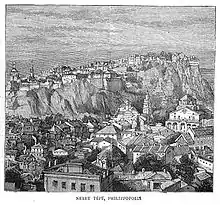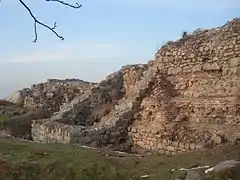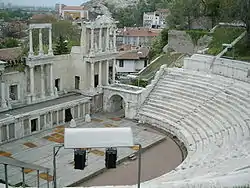Nebet Tepe
Nebet Tepe is one of the hills of Plovdiv where the ancient town was founded. The earliest settlements on Nebet Tepe are dated back to 4000 BC.[1] The site was first settled by Thracians, later expanded by Philip II of Macedon and the Roman empire. As the town expanded, Nebet Tepe became the citadel of the town's acropolis. There are remains of a fortress walls, towers, and a postern from the time of Justinian leading down to the Maritsa river. Today, the archeological complex on the hill is one of the most popular tourist sights in Plovdiv and a cultural monument of national significance.
 View from the top of Nebet Tepe | |
 Nebet Tepe Shown within Plovdiv City Center | |
| Location | Plovdiv, Bulgaria |
|---|---|
| Coordinates | 42.151236°N 24.752182°E |
| Type | Citadel, Fortress |
| History | |
| Material | bricks, marble, stone |
| Cultures | Thracians, Ancient Greek, Roman Empire |
| Site notes | |
| Condition | partially restored |
| Ownership | Plovdiv Municipality |
| Public access | Yes |
Name
The name "Nebet" comes from the Turkish words nevbet (meaning "guard") and tepe (meaning "hill") or "The hill of the guards". It is assumed that in ancient times the garrison that guarded the city was located on the hill. The hill has another name in ancient times - "The hill of Musaeus", which is associated with the Thracian Musaeus who was the most talented student of Orpheus.
History

| Part of a series on the ancient city of |
| Philippopolis |
|---|
 |
| Buildings and structures |
|
Religious
Fortification
Residential
|
| Related topics |
| • History • Timeline |
Archeology
The remains of fortress walls, towers and ancient buildings were found during the excavations on Nebet Tepe. The oldest part of the fortress on the hill was built with large syenite blocks roughly fitted together with minimal clearance between adjacent stones and no use of mortar, typical for the cyclopean masonry.[2] The remains of the Western wall with the imposing quadrangular tower and its entrance are evidence of the Hellenistic period when the ancient town expanded and the fortress on Nebet Tepe became the citadel of the town's acropolis. There are also thick stone walls from latter periods and other ancient buildings.
One of the most interesting excavations is the unique postern with staircase from Roman times - a secret tunnel in the rocks under the North wall built in the 6th century AD during the reign of Justinian. Some historians say that Apostle Paul walked through this tunnel. The postern is thought to have led to the banks of the Maritsa river.
Water reservoirs used during enemy sieges were also located on the hill. A large rectangular water reservoir with a volume of 350 cum.m is preserved in the Southern part of Nebet Tepe. It was built of alternating layers of stones and bricks while the inner walls and the floor were treated with hydrophobic coating.
Gallery
 Stone walls and ancient water reservoir
Stone walls and ancient water reservoir The water reservoir
The water reservoir The quadrangular tower and Western walls
The quadrangular tower and Western walls The inner walls of the water reservoir
The inner walls of the water reservoir Eastern wall
Eastern wall The postern
The postern Eastern fortification
Eastern fortification Ruins of ancient gate
Ruins of ancient gate
References
- Детев П., Известия на музейте в Южна България т. 1 (Bulletin des musees de la Bulgarie du sud), 1975г., с.27, ISSN 0204-4072
- archeologybg.weebly.com (in Bulgarian)



